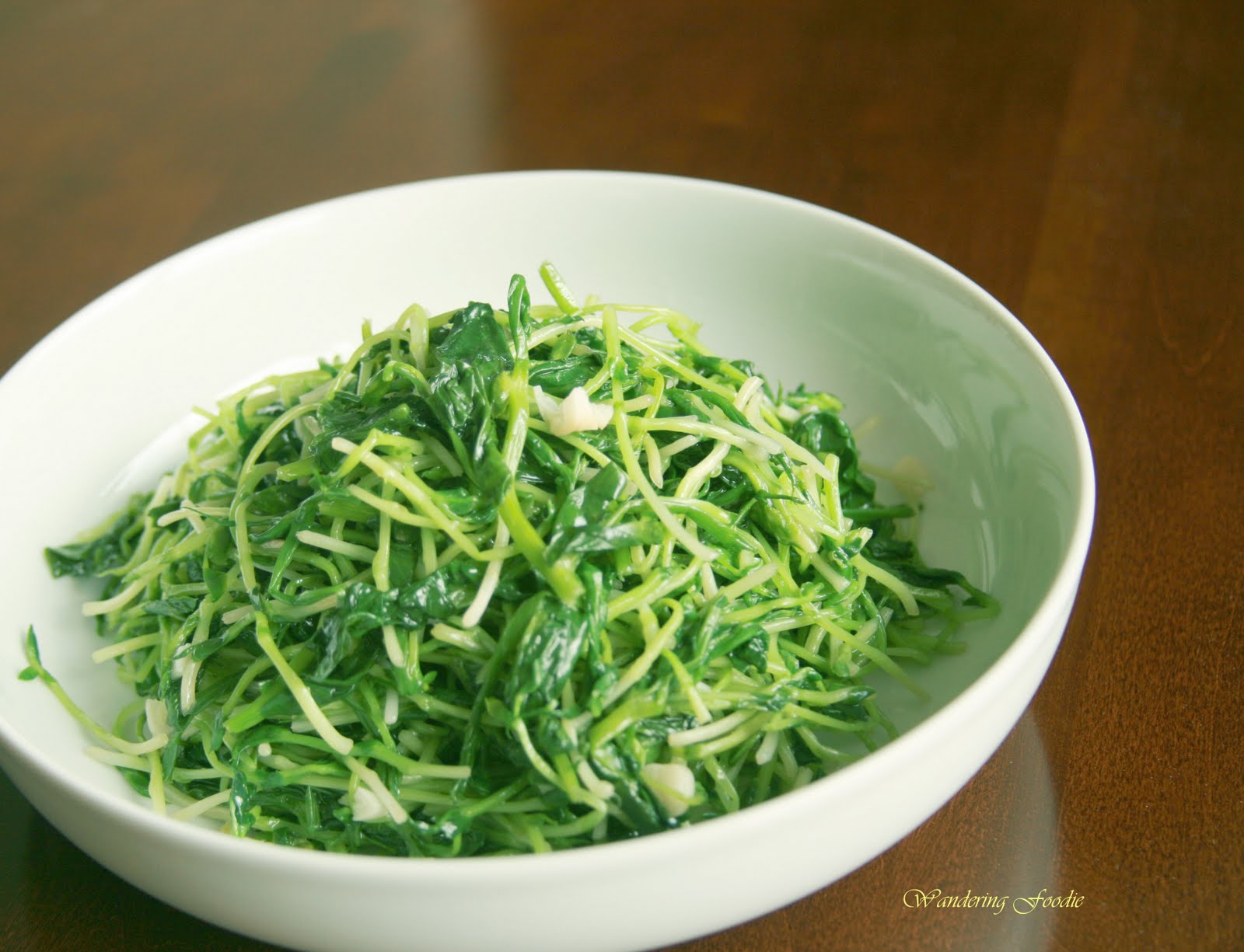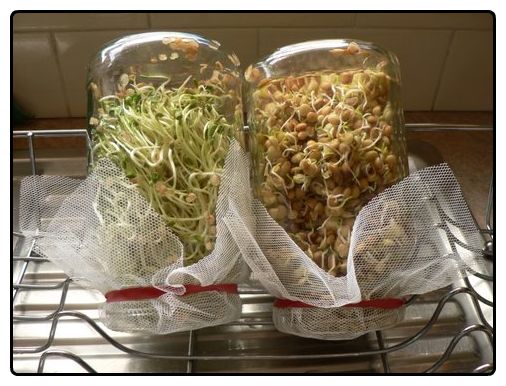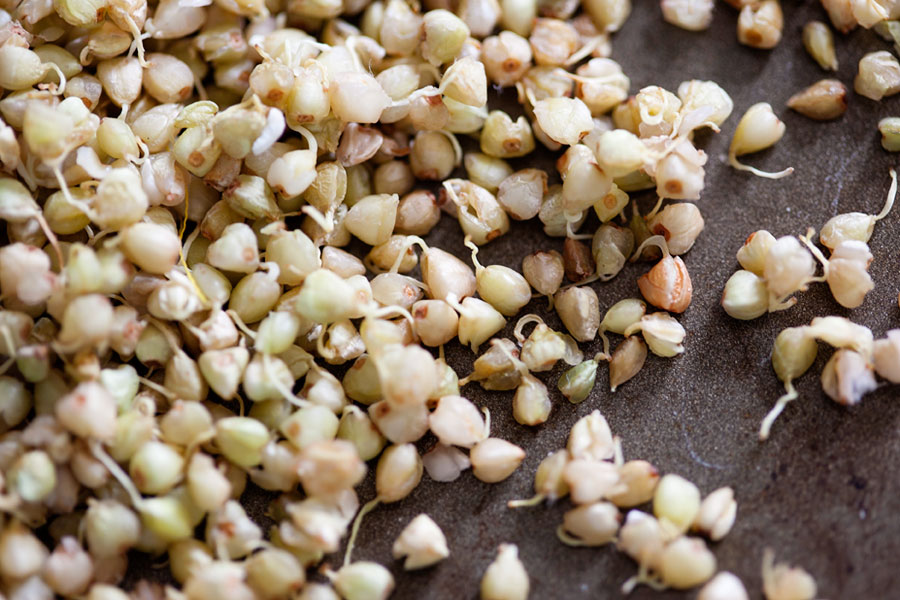What is sprouting?
If you remember elementary school, you probably remember some kind of experiment involving sprouting seeds — perhaps you stuck a few bean kernels in a jar, kept them moist, and were rewarded in a few days with green shoots.
Once early humans figured out that little kernels made plants, and that these plants were often more digestible than the little kernels, they set about finding ways to harness that process.
Thus, around the world, people figured out how to make legumes, nuts/seeds and grains more digestible by soaking, sprouting, or fermenting them.
For example, in traditional East Asian cuisines:
- cooks fermented beans such as black, red, or soybeans to make natto or pastes such as miso
- cooks used bean sprouts in stir-fries or Korean panchan (pickled/fermented side dishes)
- people consumed nieh (sprouted wheat, millet, or barley) as cereals in early China
- Neolithic Chinese made the first wine, li, from cooked rice or milled with sprouted grains
- mai ya (sprouted barley malt) appears in Chinese medicine
Indeed, some claim that most of the grains and legumes we consumed in the past were sprouted, soaked, or fermented.
Sprouting involves soaking seeds, nuts, legumes or grains for several hours, then repeatedly rinsing them until they begin to develop a tail-like protrusion.
Soaking softens the hull, allowing the sprout to grow. They are usually ready to use when the sprout is ¼ inch.

Why is sprouting so important?
A brief history of agriculture
Grains, nuts, and beans/legumes are all seeds. (Along, with, obviously, commonly eaten seeds such as sunflower or pumpkin seeds.)
Many seeds evolved to be distributed by being eaten and then excreted. Other seeds — such as many types of grain — evolved originally to be distributed by falling off the plant, or being blown by the wind.
In both cases, the seeds did not evolve to be highly digestible. Either they evolved to pass through the digestive tract unharmed, or they did not evolve to be eaten at all.
When humans developed agriculture, they cultivated many of these seeds, often breeding them to be larger and less easily dispersed.
However, the seeds often retained their indigestible properties.
Many seeds contain anti-nutrients, substances that inhibit the absorption or use of other nutrients. For example, rice contains phytic acid, which inhibits mineral absorption.
Other seeds contain substances such as lectins and saponins, which can interfere with the endothelial lining of the GI tract. This can cause damage to the cellular lining and the villi (small brushlike projections in the intestines), leading to leaky gut and poor overall nutrient absorption.
In extreme cases, such as uncooked kidney beans, raw seeds can be highly toxic (and even kidney bean sprouts should not be consumed raw). (See AA Lectins, available to PN Members.)
Thus, in order to make them edible, various agricultural populations sprouted, soaked, or fermented their seeds. (Or, as in the case of Mesoamericans and corn, prepared them with an alkaline substance, a process known as nixtamalization.)
The cultures who didn’t figure this out likely experienced mineral deficiencies and growth problems.
Nutrients and anti-nutrients
We usually notice malnutrition when nutrient-poor food is consumed. Yet, it’s still possible to consume foods rich in nutrients that cannot be utilized by the body due to anti-nutrients.
Anti-nutrients make nutrients less bioavailable, and sprouting can disable them. Anti-nutrients serve to protect a food, but can be problematic once we consume them. Still, not all anti-nutrients are problematic; some may help protect us from disease.
Once anti-nutrients are degraded with proper pre-treatment of food, legumes and grains become excellent sources of nutrients that we can utilize.
Various pre-treatment methods exist and can be used to enhance the bioavailability of nutrients, including soaking, fermentation and sprouting. Combining strategies is effective too.
Sprouting enhances the bioavailability of zinc, iron and calcium. Sprouting also reduces the phenol and tannin content in some foods.
The amount of change depends on water pH, length of soaking, and length of sprouting. However, in general, basic methods can reduce anti-nutrient levels by 50%.
When we simply heat food, not all anti-nutrients are disabled and the potential for nutrient loss increases (due to water and heat). Many vitamins can be lost with cooking, including A, D, E, B1, B5, C, B12 and folate. But remember, the bioavailability of some minerals and phytochemicals is enhanced with cooking.
While anti-nutrients aren’t helpful for nutrient absorption, they may help to prevent cancers by binding to minerals in the GI tract, hindering oxidative stress and suppressing tumor growth.
Let’s touch on a few anti-nutrients:
Phytate
- Phytate is the salt of phytic acid and is a storage form of phosphorus in grains, legumes and nuts/seeds – minimal amounts are found in roots, tubers and veggies.
- Phytate is a plant’s basic self-defense mechanism, located in the outer aleurone layer or in the germ (depending on the food).
- Phytate binds with zinc, iron, and calcium (but not copper) in the GI tract, making them inaccessible.
- Diets high in phytate can stunt growth.
- Cooking, soaking, and sprouting can reduce phytate.
Polyphenols
- These are found in most every plant food.
- Sprouting a food for 48 hours can decrease the phenol content. The decrease in phenols with sprouting seems to be due to the company of polyphenoloxidase and enzymatic hydrolysis.
- Polyphenols are not denatured by heat.
- Polyphenols, including tannins, can inhibit the digestibility of protein, minerals and starch. They actually bind and disable digestive enzymes in the GI tract.
- The most notable concern is with the minerals iron, copper, and zinc – not calcium or manganese. Vitamin B1 can also be inactivated.
- Peas are lower in polyphenols than most other legumes.
- And yes, there are also polyphenols that seem to be extremely health promoting, like catechins in tea and anthocyanins in berries.
Oxalate
- Oxalic acid is present in various plant foods, depending on the area grown. It decreases calcium absorption.
- You’ve likely heard that calcium from spinach is poorly absorbed – this is because of the oxalic acids in spinach.
- However, the calcium in kale is absorbed very well because it’s low in oxalate.
Enzyme inhibitors
- These inhibit our digestive enzymes.
- Trypsin inhibitors are one of the most common types.
- Consuming enyzme inhibitors can cause GI distress and create a long-term protein deficiency.
- Raw nuts and soy are known to contain these compounds.
- Enzyme inhibitors are reduced by cooking and sprouting.
- Some of these enzyme inhibitors are thought to play a role in cancer prevention.
Lectins
- See All About Lectins for more.
What you should know about sprouting
Sprouted seeds, grains and legumes can be consumed raw, but cooking them after sprouting might be better for nutrient absorption – especially for grains.
The sprouting process is always the same with only the length of time changing for each food. Not all foods can be sprouted (think raw cacao seeds).

The basic process for sprouting:
- Soak seeds overnight (6-12 hours) in water. Optimal time for soaking is between 8 and 10 hours.
- Rinse seeds 2-3 times daily, allow them to drain via sprouting jar or in tilted bowl.
- Sprouts will be ready in 2 to 4 days, when sprout is ¼ inch.
- Dry completely, and store in fridge for about 3 days.
Why does sprouting “work”?
Seeds soaked in warm water are fooled into thinking conditions are ripe for growth and anti-nutrients are disabled.
Soaking also allows passive diffusion of water soluble phytate.
Sprouting increases the activity of the enzyme phytase, which also breaks down phytate. The amount of breakdown varies based on stage of germination, pH, moisture, temperature and other inhibitors present. Rice, millet and mung beans in particular show large reductions in phytate with sprouting.
Sprouting neutralizes enzyme inhibitors and the sugars responsible for fermentation and intestinal gas production. Some people who complain of GI distress after eating cooked grains/legumes may tolerate the sprouted varieties.
Further, sprouting can inactivate carcinogens found in grains. At least 48 hours of sprouting time seems to be best, but this will depend on the food.
Can I sprout anything?
Not everything sprouts equally well.
Nuts like pecans and walnuts cannot be sprouted. But soaking them can boost nutrient availability.
Alfalfa sprouts are likely a bad idea and have been linked to various health problems (thanks mainly to canavanine).
And again, raw, sprouted kidney beans can cause death. Always cook them first.
Summary and recommendations
All foods are subject to nutrient losses, but the preparation method we choose can increase the bioavailability of nutrients.
In comparison to non-sprouted foods, sprouted varieties seem to be more digestible and have less anti-nutrients. While soaking and cooking can accomplish similar outcomes, sprouting seems to be just as, if not more effective.
Sprouts can be added to dishes (both raw and cooked) or eaten plain.
Extra credit
Sprouting grains can make them sweeter, since an enzyme called diastase transforms starch to sugar.
Pea protein supplements and sprouted grain rice protein supplements don’t seem to contain the same anti-nutrients as whole peas and rice. Soy protein supplements however, still possess anti-nutrients.
Amylase is increased during sprouting, which can reduce the viscosity of cereal porridges.
Some epidemiological studies show low iron stores with high consumption of tea or coffee, since those beverages are rich in polyphenols.
While mineral loss is substantial during refining, we absorb the remaining few very well due to anti-nutrient removal. Yes, this means you might actually absorb more minerals from refined grains.
Buckwheat has antioxidants that are activated during sprouting.

References
Click here to view the information sources referenced in this article.
Learn more
Want to get in the best shape of your life, and stay that way for good? Check out the following 5-day body transformation courses.
The best part? They're totally free.
To check out the free courses, just click one of the links below.





Share